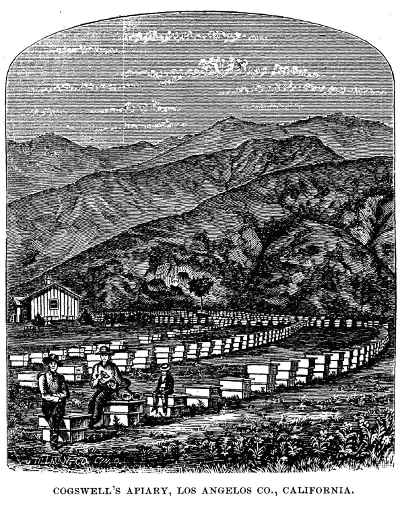
Honey hunters and migratory beekeepers
 Some of the most vivid imagery in Bees in America
involves honey hunters and migratory beekeepers. Horn reports
that during the colonial era, American honey hunters would search
through the woods throughout the spring and summer looking for wild bee
trees. The journey would usually begin when the honey hunter set
out a plate of flour surrounded by flower petals, attracting and marking
the bees at the same time. By following the path of the now-white
bees through the air (a technique known as coursing), the honey hunters
were able to locate the bee tree, then to mark it with a slash on the
bark to demonstrate ownership. Come fall, when the bee tree was
full of honey, the honey hunter would return, cut down the tree, and
split the sweet profits with the landowner.
Some of the most vivid imagery in Bees in America
involves honey hunters and migratory beekeepers. Horn reports
that during the colonial era, American honey hunters would search
through the woods throughout the spring and summer looking for wild bee
trees. The journey would usually begin when the honey hunter set
out a plate of flour surrounded by flower petals, attracting and marking
the bees at the same time. By following the path of the now-white
bees through the air (a technique known as coursing), the honey hunters
were able to locate the bee tree, then to mark it with a slash on the
bark to demonstrate ownership. Come fall, when the bee tree was
full of honey, the honey hunter would return, cut down the tree, and
split the sweet profits with the landowner.
Another story that really
captured my interest involved French beekeepers in Maryland and
Pennsylvania in the 1600s. These early migratory beekeepers kept
their hives on flatboats, traveling at night and anchoring beside
flower-filled meadows each day to maximize their honey production.
Later, migratory beekeepers used the
railroad and then trucks to move their bees, being paid for pollination
(in addition to being able to sell their honey)
by the beginning of the 1900s. In fact, by the second half of the
twentieth century, pollination services had become more lucrative than
producing honey, with some beekeepers receiving $32 per hive placed in
almond orchards in the 1990s.
| This post is part of our Bees in America lunchtime series.
Read all of the entries: |
Want more in-depth information? Browse through our books.
Or explore more posts by date or by subject.
About us: Anna Hess and Mark Hamilton spent over a decade living self-sufficiently in the mountains of Virginia before moving north to start over from scratch in the foothills of Ohio. They've experimented with permaculture, no-till gardening, trailersteading, home-based microbusinesses and much more, writing about their adventures in both blogs and books.
Want to be notified when new comments are posted on this page? Click on the RSS button after you add a comment to subscribe to the comment feed, or simply check the box beside "email replies to me" while writing your comment.
